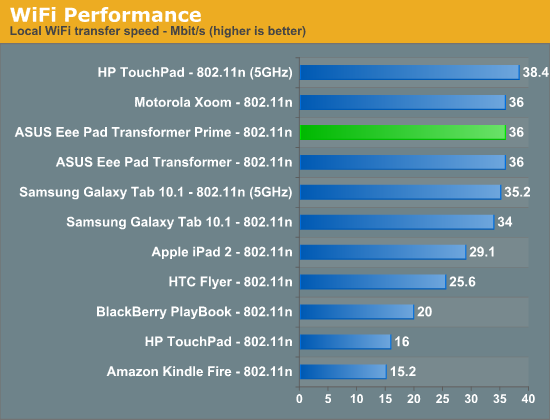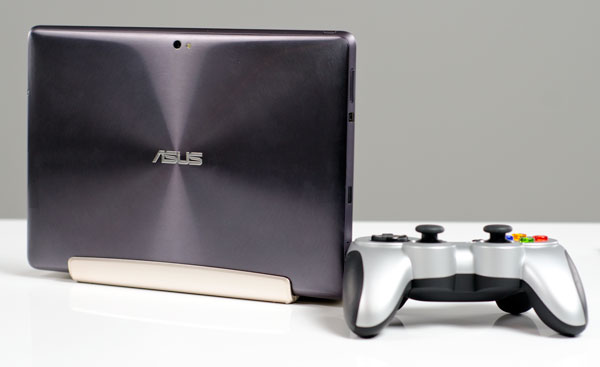ASUS Eee Pad Transformer Prime Review Part II: Battery Life & More
by Anand Lal Shimpi on December 15, 2011 3:45 AM ESTIn our original review of the ASUS Eee Pad Transformer Prime I did the best I could do given limited testing opportunity with the platform before the NDA lifted on all the reviews. I made the commitment back then to come back with additional findings after I had spent more time with the platform. Today I'm back to make good on that promise.
Two more Eee Pad Transformer Prime samples later and here we are. Next week retailers and etailers should begin shipping the first orders of the Prime out to customers. There were a number of gaps I wasn't happy with in our original review of the Prime, and I've spent the past couple of weeks trying to fill them. Even what I'm presenting today isn't perfect, but when combined with the original review it should paint a more complete picture of the Eee Pad Transformer Prime.
And I've got video, something I had to cut out of the original review due to time constraints:
The WiFi Story
I'm on my third Transformer Prime. The original sample was almost completely broken when it came to wireless connectivity. I had very little range on the integrated WiFi and performance typically hovered around 0.5Mbps, sometimes reaching as high as 2Mbps. ASUS originally claimed that no one else had this issue but it looks like the CNet reviewer also noticed it. That sample went back to ASUS for diagnosis but I don't have the results back from the autopsy yet. A simple guess would be an antenna that wasn't properly connected, although it could just as easily have been something more complicated.
ASUS overnighted me a second Transformer Prime; this one was tested at ASUS in California before making its way out to me. As I published earlier, I had issues with the second sample and any Apple wireless access points (Time Capsule or Airport Extreme). Using a Netgear AP I saw 16Mbps pretty consistently, but I could only get ~32Mbps if the tablet was at the right orientation with respect to the AP. ASUS' HQ eventually conceded that there might have been a problem with the second WiFi antenna on pre-production review samples. Apparently this issue was fixed in the retail lot, but may not have been addressed in what ASUS originally shipped us. Wait—second WiFi antenna?
It turns out that the Eee Pad Transformer Prime features WiFi antenna diversity. We've talked about antenna diversity most often with reference to the cellular chain on Apple's iPhone 4 and 4S, but here it's present on the Prime's WiFi. There are two antennas on the Transformer Prime, one located on either side of the front facing camera. In the second Transformer Prime sample, one of the two wasn't working. In my third review sample, taken from the retail lot that's on its way to vendors this week, both were fully functional. The result is peak WiFi performance that is virtually identical to the original Eee Pad Transformer.

There is no RF window on the back of the Prime where the two antennas are located. Aluminum does a fairly good job of attenuating RF signals, which contributes to worse range on WiFi than the original plastic Eee Pad Transformer. WiFi performance at the edge of reception as well as the maximum usable WiFi range are both noticeably lower than its predecessor. I'm still finalizing our tablet WiFi range tests to be able to quantify some of this stuff, but it's safe to say that if you were at the edge of WiFi coverage on the original Transformer, the Prime won't be any better.

















58 Comments
View All Comments
medi01 - Thursday, December 15, 2011 - link
It's not about "what is Prime's color gamut", but rather "how does it compare to other tablets".Hopefully it will become standard part of your tests, since brightness/contrast tell only small part of the story.
Ric_Margiotta - Thursday, December 15, 2011 - link
Thanks for this follow-up article, Anand! It was a good read and answered some of my remaining questions about the TF Prime. Still looking forward to picking one of these up in January!sotoa - Thursday, December 15, 2011 - link
Too bad these weren't ready in bulk for Christmas. Not to mention ICS.tipoo - Thursday, December 15, 2011 - link
I read elsewhere that engineering samples of Tegra 3 weren't performing as much better as Nvidia originally expected them to, due to the cores and GPU being constrained for memory bandwidth. I don't know of them changing this in the original design. I'm curious how much ICS will improve T3 performance with its better multithreading and better GPU acceleration, and how much comes down to all the elements competing for bandwidth or some other hardware limitation?druter - Thursday, December 15, 2011 - link
I guess we should not have expected a non apple slanted review from such a mac fanboy site. I dispair for tech journalism when the point becomes less about an honest unbiased review and more about ones allegiance to apple.Nice try though to sound unbiased though, stating that it is a much improved tablet, your apple bias showed through though when you indicated you felt that it was only in comparison to other Androids and that it was still below anything Mac.
The lesson I learned don't come to Anandtech.com when you want an honest unbiased review.
piiman - Thursday, December 15, 2011 - link
If you think this is an Apple fan site why do you even come here? Just so you can bash the reviews?tipoo - Thursday, December 15, 2011 - link
What parts of this came across as biased? To me it seemed all the facts were laid out impartially, and they put effort into correcting the old battery life measurements as well as promised performance updates when ICS hits. If everything comes back to the iPad, its for a reason, like it or not its still the standards bearer for these tablets, and I'm a hardcore Android user. I think the Prime will be better than the iPad personally when ICS hits, but the review is based on current software of course.IKeelU - Thursday, December 15, 2011 - link
It's important to show how it performs against the iPad, especially with regards to battery life. Most people don't care about android vs iOS, they just want a media consumption device, and will therefore choose the device that allows them to do that better.Second, the numbers for battery life are in Apple's favor. It would be biased to ignore them.
Sounds to me like you would be better served by going to an Android fanboy website.
Belard - Thursday, December 15, 2011 - link
You are a fool druter. I and others do not know WHAT you think you read or watched.A) Anand isn't much of a tablet user (AFAIK from his previous articles)
B) He uses all kinds of technology - he does have the right to use what he wants for his personal uses, no? He uses AMD and intel for his own servers and in general - has kept standards pretty good on this sight.
C) All devices WILL compare market leaders, including the iPad. With what is on the market TODAY from Samsung, ASUS, Toshiba, etc - None of them have the battery or GPU (graphics) performance of the 9 month old iPad2 and some are below that of an iPad1 especially when it comes to battery life.
D) "below anything mac"?? he didn't compare the TF-Prime to any Mac. Apple only has one type of tablet on the market and its NOT a Macintosh. He stated the simple fact that tablets DO NOT replace actual notebooks. That is true if the iPad2 as well.
E) Use the best tool for the job or personal preference and budget. Simple as that, eh? I build my own desktops, own ThinkPad notebooks and have an iPad. My dislike for apple is the same for Microsoft, so it just doesn't matter.
F) Get over yourself.
melgross - Thursday, December 15, 2011 - link
Some people aren't happy unless something is reviewed as being much better than any comparable Apple product.Like it or not, the iPad is still the gold standard, and everything is going to be compared to that. This guy will be very unhappy in March when the new one comes out.